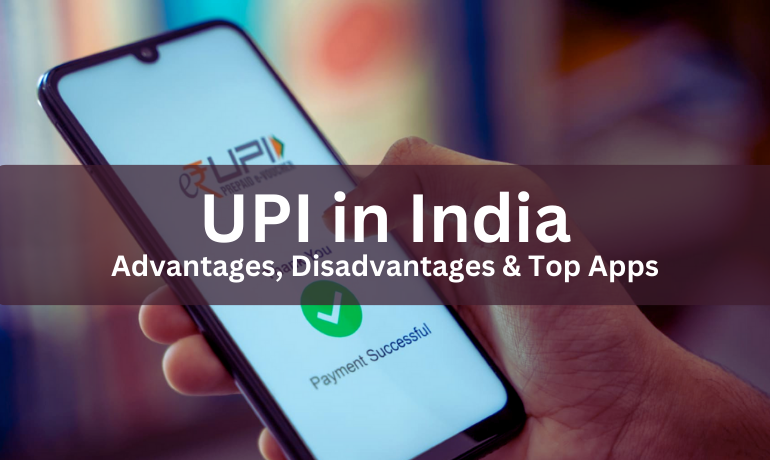In recent years, the Unified Payments Interface (UPI) has revolutionized the way financial transactions take place in India. This innovative system has redefined the ease and speed of money transfers between bank accounts, making it a cornerstone of the country's digital financial landscape. UPI offers a seamless platform that allows users to link multiple bank accounts, conduct transactions, and make payments through their mobile devices. In this comprehensive guide, we'll delve into the advantages and disadvantages of UPI, while also exploring some of the Top UPI App in India, simplifying the landscape of digital payments for users across the nation.
What is the Unified Payments Interface (UPI)?
UPI, or Unified Payments Interface, is a real-time payment system in India that facilitates instant money transfer between bank accounts via mobile devices. Developed by the National Payments Corporation of India (NPCI), UPI allows users to link multiple bank accounts to a single mobile app, enabling seamless transactions, bill payments, and more.
Pros of UPI:
- Instant Transfers: UPI enables immediate fund transfers 24/7, including weekends and holidays, directly from one bank account to another.
- Convenience and Ease of Use: It provides a user-friendly interface, making transactions simple and quick. Users can make payments using UPI IDs or by scanning QR codes without entering bank details each time.
- Multiple Bank Account Linkage: Users can link multiple bank accounts to a single UPI app, providing convenience for those holding accounts in different banks.
- Enhanced Security: UPI transactions are secured by two-factor authentication, offering a higher level of security for financial transactions.
Cons of UPI:
- Internet Dependency: UPI transactions require a stable internet connection, which might be a limitation in areas with poor connectivity.
- Security Risks: Despite robust security measures, there is a risk of fraud or unauthorized transactions due to phishing attacks, malware, or unauthorized access.
- Transaction Limits: UPI transactions have daily transaction limits set by banks and UPI service providers, which might vary among users and banks.
- Compatibility Issues: Some UPI apps might not be compatible with all smartphones or operating systems, leading to compatibility problems for some users.
Best UPI Apps in India:
- Google Pay (formerly Tez): Known for its simplicity, security, and seamless integration with various services, Google Pay is a widely popular UPI app in India.
- PhonePe: It offers a user-friendly interface, cashback offers, and a range of services beyond payments, such as shopping, bill payments, and investments.
- Paytm: A versatile app that initially gained popularity for mobile recharges but now offers a wide range of services including payments, shopping, and financial services.
- BHIM (Bharat Interface for Money): Developed by NPCI, BHIM is known for its simplicity and direct integration with bank accounts.
- CheqUPI: CheqUPI is an emerging UPI app that focuses on providing a secure and user-friendly experience for making payments. It emphasizes security and seamless transactions, striving to offer a trustworthy platform for UPI transactions.
Frequently Asked Questions (FAQs) about UPI:
What is UPI (Unified Payments Interface)?
UPI is a real-time payment system in India that enables instant money transfers between bank accounts via mobile devices. It allows users to link multiple bank accounts into a single mobile app for seamless transactions and payments.
How does UPI work?
UPI works by creating a unique UPI ID or virtual payment address, linked to a bank account. Users can make payments by using this UPI ID or scanning QR codes. Transactions are processed instantly between bank accounts.
Is UPI safe and secure for transactions?
UPI transactions are secured with multiple layers of authentication, including MPIN, biometric verification, or OTP. However, users should also take precautions such as safeguarding their UPI PIN and not sharing sensitive information to enhance security.
Can I link multiple bank accounts to a single UPI app?
Yes, UPI allows users to link multiple bank accounts into a single UPI app. This feature provides convenience for those who hold accounts in different banks.
What are the transaction limits for UPI transactions?
UPI transactions have daily transaction limits set by banks and UPI service providers. These limits vary among different users and banks. Users should check with their respective banks or UPI apps for their transaction limit details.
Are there fees associated with using UPI?
Many banks and UPI service providers offer UPI transactions free of charge. However, there might be certain charges for specific types of transactions or after exceeding the set limits. Users should verify any applicable fees with their banks or UPI apps.
What if I lose my mobile phone with the UPI app installed?
If your phone is lost or stolen, immediately inform your bank and UPI service provider to temporarily block or deactivate your UPI account to prevent unauthorized access or transactions.
Can UPI be used without an internet connection?
UPI transactions primarily require a stable internet connection for processing. However, efforts are underway to make UPI accessible through feature phones and USSD technology, allowing users with non-smartphone devices to use UPI services.
Is UPI only for payments or can it be used for other purposes?
Apart from payments and money transfers, UPI can be used for various purposes, such as bill payments, ticket booking, and shopping on various platforms that accept UPI payments.
Can I reverse a UPI transaction if I've sent money to the wrong UPI ID?
UPI transactions are immediate and irreversible. Therefore, users should double-check the recipient's details before confirming the transaction to avoid sending money to the wrong ID.


